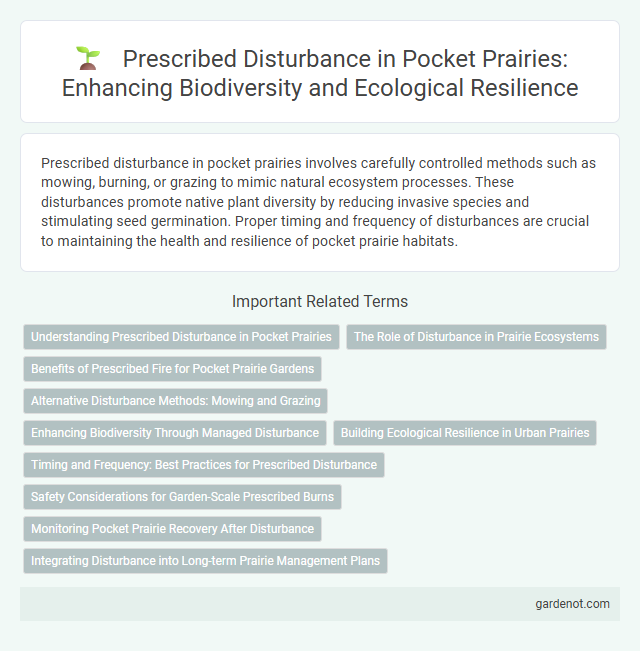Prescribed disturbance in pocket prairies involves carefully controlled methods such as mowing, burning, or grazing to mimic natural ecosystem processes. These disturbances promote native plant diversity by reducing invasive species and stimulating seed germination. Proper timing and frequency of disturbances are crucial to maintaining the health and resilience of pocket prairie habitats.
Understanding Prescribed Disturbance in Pocket Prairies
Prescribed disturbance in pocket prairies involves carefully planned interventions such as controlled burns or mowing to mimic natural processes that maintain ecosystem health. These disturbances promote native plant diversity, control invasive species, and improve habitat quality for pollinators and wildlife. Understanding the timing, frequency, and intensity of prescribed disturbances is crucial for sustaining the ecological balance and resilience of pocket prairies.
The Role of Disturbance in Prairie Ecosystems
Prescribed disturbance plays a crucial role in maintaining the health and biodiversity of pocket prairie ecosystems by mimicking natural events such as fire or grazing that prevent woody plant encroachment. These disturbances promote native plant regeneration, enhance soil nutrient cycling, and support diverse wildlife habitats. Regularly managed disturbances help sustain the ecological balance, ensuring resilience against invasive species and environmental stressors.
Benefits of Prescribed Fire for Pocket Prairie Gardens
Prescribed fire in pocket prairie gardens promotes nutrient cycling by rapidly decomposing organic matter and releasing essential nutrients back into the soil, enhancing plant growth. This controlled disturbance reduces invasive species and accumulated thatch, maintaining native biodiversity and habitat structure critical for pollinators. Fire also stimulates germination of fire-adapted prairie seeds, ensuring species regeneration and long-term ecosystem resilience.
Alternative Disturbance Methods: Mowing and Grazing
Alternative disturbance methods such as mowing and grazing effectively mimic natural processes in pocket prairies to maintain biodiversity and control invasive species. Mowing reduces woody plant encroachment and promotes native grass growth by simulating periodic disturbances historically caused by fires and large herbivores. Grazing by livestock like bison or cattle maintains plant diversity through selective feeding, soil disturbance, and nutrient cycling, enhancing habitat quality for pollinators and wildlife.
Enhancing Biodiversity Through Managed Disturbance
Prescribed disturbance in pocket prairies promotes biodiversity by mimicking natural processes such as controlled burns or selective mowing, which reduce invasive species and stimulate native plant growth. These managed disturbances create heterogeneous habitats that support a diverse array of pollinators, insects, and ground-nesting birds. Regularly scheduled disturbances maintain ecosystem balance, enhance soil health, and increase plant species richness, contributing to long-term sustainability of pocket prairie environments.
Building Ecological Resilience in Urban Prairies
Prescribed disturbance techniques such as controlled burning and targeted mowing are essential for building ecological resilience in urban pocket prairies by promoting native plant diversity and suppressing invasive species. These disturbances mimic natural processes, enhancing soil health, nutrient cycling, and habitat complexity critical for pollinators and wildlife. Implementing regular prescribed disturbance schedules ensures sustainable ecosystem functions and adaptive capacity in fragmented urban landscapes.
Timing and Frequency: Best Practices for Prescribed Disturbance
Optimal timing and frequency of prescribed disturbances in pocket prairies depend on seasonal plant growth cycles and ecosystem goals to promote native species and suppress invasives. Conducting disturbances during early spring or late fall aligns with dormant phases of many perennials, minimizing harm to native flora. Maintaining a disturbance frequency of every three to five years supports biodiversity, soil health, and habitat resilience without causing undue stress to the prairie ecosystem.
Safety Considerations for Garden-Scale Prescribed Burns
Garden-scale prescribed burns require strict adherence to safety protocols to prevent unintentional wildfires and protect nearby structures. Key considerations include creating firebreaks, monitoring weather conditions such as wind speed and humidity, and having fire suppression tools readily available. Proper training and permits are essential to ensure the burn is controlled and environmentally beneficial within the pocket prairie setting.
Monitoring Pocket Prairie Recovery After Disturbance
Monitoring Pocket Prairie recovery after prescribed disturbance involves systematic assessment of vegetation regrowth, soil health, and biodiversity indicators to evaluate restoration success. Regular data collection on native species cover, invasive species presence, and soil nutrient levels enables adaptive management strategies to enhance ecosystem resilience. Employing remote sensing and on-ground surveys provides comprehensive insights into successional changes and habitat quality over time.
Integrating Disturbance into Long-term Prairie Management Plans
Integrating prescribed disturbances such as controlled burns and targeted grazing into long-term pocket prairie management plans enhances plant diversity and ecosystem resilience. These disturbances mimic natural processes, promoting native species regeneration while suppressing invasive plants. Careful scheduling and monitoring of disturbances ensure sustainable habitat conditions and support the prairie's adaptive capacity over time.
Prescribed disturbance Infographic

 gardenot.com
gardenot.com